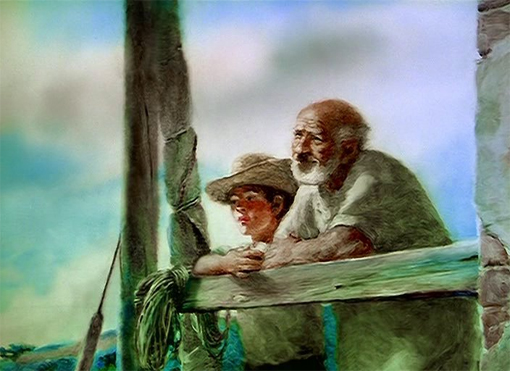Any discussion of the different styles of animation invariably cover traditional, digital, stop-motion, paper cut-out, sometimes even puppetry. But there is one style that is rarely mentioned, maybe because only a handful of brave souls have ever tried it: paint-on-glass animation. Interestingly, virtually all of those brave souls are either Canadian or European (which is another way of saying, don’t expect Ice Age on Glass any time soon).
One of the most notable examples of this style remains Russian animator Aleksandr Petrov’s 1999 adaptation of Hemmingway’s The Old Man and the Sea, which was the first animated film released in the IMAX format. Back in ’99 I spoke with the film’s producer Bernard Lajoie, the head of Montreal’s Studio Pascal Blais, about the painstaking creation of the film:
“He [Petrov] is using oil paint on glass, lit from behind, painting every frame with paint that doesn’t dry on his finger. He takes a frame, modifies it directly under the camera, takes another frame, modifies it, and on and on and on for days and weeks and years. Because of the elements, water and nature, the film required full animation. It is total animation all the way through, including the landscape. Aleksandr is animating directly under the camera, so if he does make a mistake, he has to start again. There’s no drawing to replace and be reshot. What we have left at the end of the scene is the last frame of it. It’s more like stop motion, but with paintings. He was working in a field of 24-to-30 inches wide, sometimes more, but an average of four levels of glass.”

By the way, that reference to “years” Lajoie was not figurative. Aided only by his son Dmitri, Petrov worked on the film for two-and-a-half years, filming 29,000 individually manipulated paintings, shot mostly on ones, but sometimes on twos. An even greater challenge, according to the producer, was that there was no existing technology to draw upon when the decision was made to shoot the film in 65mm IMAX format. “We had to develop the animation stand and it took us about six to eight months to build it from scratch,” Lajoie told me, adding:
“It had to be ten times more precise and adapt the design of the table in order for Petrov to be able to animate. What we did was develop an animation stand with a 14-foot column and four levels of glass moving north, south, east, and west, moving like a multiplane camera. That was kind of tricky because he had to work at four levels and have access between the different levels. We had to find the proper opticals and double-compound system for each plate so that you can push one plate, bring it back into position, and not lose the accuracy we required, which was one ten-thousandth of an inch repeatable on each axis, so the image looks stable on screen.”
Petrov and Lajoie’s long, hard work was rewarded in 2000 when The Old Man and the Sea won the Oscar. Even before that, though, Lajoie said that Petrov took a well-deserved break from filming…to go fishing.
You can check out the acclaimed short here:







MIchael,
I started animating paintings on glass in the late 80’s using the remote control of my 8mm Sony camcorder. I produced :Moving Paintings Vol 1 with soundtrack by different artists, but mostly Gustavo Santaolalla, who has won numerous Grammys and 2 Oscars. The production won 2 silver medals at bothe the New York and Chicago Int’l Film and Video festivals.The link is to an animation I did in 2001, which illustrated the original VO story. The soundtrack for “Kabala” was replaced with the song by Jai Uttal, which lets the animated paintings tell the story. As you can imagine, animating to a timed narration with liquid, flowing paint was also very challenging and nearly impossible to control, so yes it took a brave heart.
https://www.youtube.com/watch?v=-tTwPZr4sQg